Every interior designer has a website nowadays. Not having one would quickly put a man out of business.
However, if we look closely at the majority of such websites, we’ll observe clearly traceable patterns. A couple of quick links here, a portfolio slideshow there. Why do they look so alike? And what does it take for a formidable interior designer to truly stand out from the crowd?

Why the copy & paste?
Website templates for interior designers are everywhere. Cheap, ready-to-use solutions such as WordPress and Joomla have become extremely popular. They require little to none technical skill to be launched and cost from $2,000 to $5,000. And from the first glimpse, they look fairly well, indeed!
Well, here is the problem. In interior design business, there are two types of players:
Hungry rookies. They are new to the market and try to get their hands on every project they can possibly contract. Such designers will work in all possible styles and architectural trends, and, at this point, all that matters to them is a functional website for an interior design company for a modest fee. This is where an interior design website template would shine.
Veterans. They have vast experience in the field and a sterling customer satisfaction record. These people cannot afford to look like someone else. They have a distinct specialization (whether it is Loft, Hi-Tech, or Baroque), which they are renowned for. Their website must project their unique style to the blue screen. Professional interior designers never use templates and should not resort to them for the online showcase, either.
Now, let's look at these two categories from the client’s point of view. The client looks for an interior design service and gets bombarded by rookie offers, which are, to client’s judgment, decently portrayed on the web. What would it take to convince such client to pay more for a reputable service offer?
The only thing that can is the impeccable website.
Where to begin?
Start with yourself. Just like fashion design, interior design is very person-centered. Even if it’s a large agency with hundreds of employees, it will likely bear its founder’s name. Being creative minds, such people possess their own sense of aesthetics, which is clearly perceived from their works and must be just as clear from their websites.
Subconsciously, the client will transfer the image of the website into their service expectations. A mediocre website would make them expect a service of similar quality. In one of our previous articles, we talked about how the website acts as a “wrapping” of the product you are trying to showcase. This statement couldn't ring truer for interior design websites.

With all the wide variety of templates out there, it’s impossible to find the one to perfectly match the interior designer’s character and style. Only a renowned, award-winning web agency with a personal approach to the client is capable of achieving such synergy.
3 crucial things you need to build an outstanding interior design website
So which points must the best interior design websites focus on? Let us try to sum them up. The major criteria would be the following:
- Transmit the level of greatness. It has to be clear from the first glimpse that this designer is not a beginner, but an accomplished professional, the trendsetter, the best in their niche.
- Embody the style. The web agency must perceive the designer’s unique style, and transfer it to a digital display.
- Reveal the personality. An accomplished interior designer puts their very soul into every project they do. Their website must reveal the identity behind all those projects. Embedded video clips are one way to achieve it.
There would also be some general criteria, which are true for most up-to-date websites:
- Fast loading. A designer’s portfolio will contain a lot of images, and probably, some videos, too. It is the web agency’s job to organize them in such a way that their loading time does not bore the potential clients.
- Adaptive interface. It may be surprising, but, according to the latest surveys, people are more likely to browse websites from mobile devices than desktops (58% for mobile, 42% for desktop). Failure to adapt to the small screen is already causing a lot of trouble even to world’s top players.
- Calls to action. Simply showcasing your works is not enough. The site has to market your design ideas and appeal to your potential clients’ taste.
What’s on the bill?
Even if we take into account all features listed above, it’s rather difficult to estimate timeframe and cost of such website project. A designer’s website is a creative work, which is hard to measure in dry figures.
However, based on the number of pages and animations, we can make a guess on the approximate costs of websites that are already produced. Have a look at Makhno and Karim Rashid creative interior design websites. A project of such scale would take 1,200-2,000 working hours (design, programming, animations), which would account for $7,000 - 15,000 in India, $20,000 - 50,000 in Eastern Europe and $50,000 - 250,000 in the U.S. However, capability of Indian agencies of creating websites of such level is highly doubtful - we rarely see a company from India among international competitions prizewinners. On the other hand, Eastern European agencies are known for their formidable works.
How high can we go?
Let's say, we are building a website for the richest interior designer in the world. What would we achieve with an unlimited budget? How would such website look like?
First of all, we would develop and implement a detailed strategy for pre-scheduled update. This would turn our website into a living creature. Prudently planning and gradually adding new content is what keeps the user’s interest. Marketing knacks from the video gaming industry would work flawlessly here: people would strive for new website features and interior design cases, especially, having the next thing in mind.
Virtual reality adaptation - an expensive but really awesome feature to integrate. Oculus Rift and HoloLens technologies enable vivid experiences. What is a better showcase than showing the interior design from inside?

Last but not least, it is a good idea to tell interactive stories of happy clients who moved in the designed residences. By seeing how their lives changed, new clients would create an empathetic bond and project themselves onto these stories.
Every formidable designer has their unique style. An interior designer embodies their style in living spaces. A web designer carves it into websites. For both designers, it is important that the essence of their style is perceived by their clients. And this, to me, is the main goal that a website must achieve.

View Comments